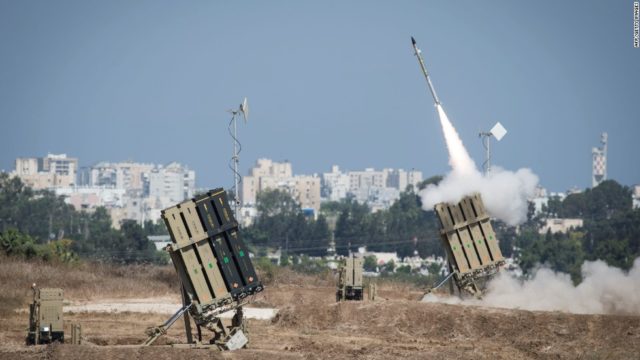If necessity is the mother of invention, Israel has come up with missile defense systems that meet its necessities and which others are now keen to deploy.
On Israel’s southeast, the Hamas arsenal includes mortars and rockets including the upgraded Qassam, Katyusha, GRAD and the new Iranian M-302, M-75 and Fajr-5. Two hundred rockets and mortars were fired on one day in July, and Israeli cities, including most recent parts of Tel Aviv, are within range.
Iranian-armed Hezbollah has more than 100,000 rockets and missiles in Southern Lebanon pointed at Israel, and increasingly, they are precision guided. Hezbollah also has an arsenal of Iranian-supplied drones.
In response, Israel has produced technologies long sought by the United States but generally not available to American troops. The “Not Invented Here” syndrome, with its accompanying desire to feed American defense contractors, has delayed serious American consideration of Israeli technology.
Until now.
Iron Dome was developed by Israel – with the American partnership of Raytheon for the Tamir interceptor missile that is part of the Iron Dome – and was introduced in March 2011 to deal with short-range rockets, mortars and artillery rounds. It has a sustained success intercept rate of more than 90%, achieved by its ability to select targets that are likely to hit populated areas or sensitive military or economic sites. Missiles on a trajectory to hit the sea or empty spaces are not targeted for an interception.
Iron Dome Impresses
After watching it in battlefield operations for nearly nine years, the US army is buying two Iron Dome anti-missile systems and may be giving up a quest to build its own Iron Dome-like system. The announced acquisition – and parallel request to Congress to fund the procurement – comes shortly after the US Army purchased 240 Israeli Trophy systems for its M1 tanks. Trophy mounts directly on the vehicle to stop incoming anti-tank missiles and mortars.
The US Army has been pushing a program for many years called the Expanded Mission Area Missile, which it wants to add to its Indirect Fires Protection Capability. Iron Dome’s Tamir Missile, produced jointly with Raytheon, was one of the entries for the Expanded Missile missile. Others came from big US contractors including Lockheed. Iron Dome, however, offers not only missile superiority but a much better radar and more sophisticated fire control system.
Iron Dome is used against missiles and drones. In fact, the US Army tested it specifically against drones because they are now globally available – some commercially, many coming from China, and even more home-built with motors and electronics, also coming mainly from China. Iron Dome successfully met the Army’s expectations.
Iron Dome uses a sophisticated liquid-fueled warhead and laser proximity sensor. The most recent US Patriot intercept missiles (PAC-3) replace an exploding warhead with a hit-to-kill vehicle, essentially using kinetic energy to destroy an incoming missile.
Using a hit-to-kill missile against a very short-range missile used by terrorist organizations may make matters worse rather than better because the missile may be thrown well off course and still do significant damage.
Different Roles
In recent Patriot firings against Houthi-Iranian tactical missiles, while the missiles were hit, the warheads still appeared to explode near their targets, which speaks more to the poor accuracy of these missiles than the work of the Patriot in intercepting them.
Of course, the role of Patriot and Iron Dome are significantly different, but relying solely on Patriot for air defense is much too costly. For example, Patriot has been used to shoot at drones that probably cost only a few thousand dollars each. It hardly makes sense.
Not only is Iron Dome the world’s leading C-RAM, or counter rocket, artillery and mortar, system, it is far less costly than existing missile defense systems and its interceptor missiles – at $40,000 to $50,000 each – are far more cost-effective than Patriot interceptor missiles, which cost roughly $2 million each.
When Poland was recently offered four Patriot missile batteries at a price of $10.5 billion, the government went into collective “sticker shock.” In the end, Poland agreed to buy two Patriot batteries and two firing units at a cost of $4.5 billion.
By contrast, the US Army is initially buying two Iron Dome systems at an overall cost of $373 million, which includes 12 launchers, two radars and 240 missiles. This won’t be nearly enough, but it is a good first step.
Israel’s Other Systems
Israel has other systems of its own design to deal with longer range weapons – Arrow, the latest version Arrow III, to deal with intermediate range ballistic missiles in the exo-atmosphere, David’s Sling to intercept enemy planes, drones, tactical ballistic missiles, medium- to long-range rockets and cruise missiles, replacing Patriot, Barak-8 to deal with anti-ship missiles, and the forthcoming Iron Beam to destroy short-range rockets, artillery, and mortars with a range of up to 7 kilometers – too small for Iron Dome to intercept effectively.
According to a January 20 report in The Times of Israel, a Syrian missile was shot down by Israel as it headed to a populated area.
As missile, rocket and drone threats multiply and increase in sophistication, the US Army’s Iron Dome purchase should be seen as the first of many opportunities to take advantage of the proven capabilities of its allies and partners. There is no time, money or reason for Not Invented Here to rule in Pentagon decision-making.


